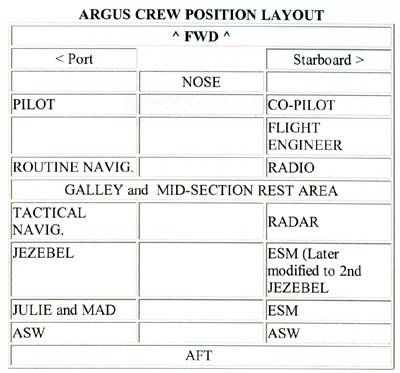 |
| These were the crew positions prior to the 1978ish time frame. |
 |
| These were the crew positions prior to the 1978ish time frame. |
CREW COMPLEMENTPost 1978, this was the crew compliment. and the wings they wore.
 |
Three Pilots (officers),'two would fly the airaraft with one in crew rest area. The lead pilot was known as the VPCC (VP – US a navy term for fixed wing, CC – Crew Commander) |
 |
Two Flight Engineers (Sgt or WO, the Sqn also had a Capt FE), one sitting in the FE seat, the other in crew rest. |
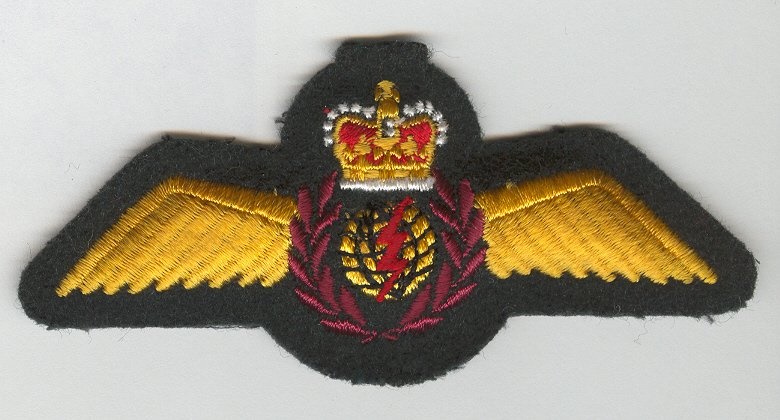 |
Five Air Navigators (Officers). The ANavs manned the Routine Nav position
(the long-range navigation), two at the TacNav table (Tactical Navigation
position), and two each operating an AN/AQA-5 Acoustic Charts Recorder
(Acoustic Processing System, Jezebel, LOFAR. The positon that all
ANav’s aspired to was to be the TACCO (the Tactical Coordinator), all the
other ANavs rotated through the positons during the flight (Routine Nav,
Tac Nav, Jez, off).
The original Navigator wings had just a globe in the centre, the Navigator/interceptor Wings (Voodoo Air Navigators had the globe with the lightening bolt), and the in the 70’s the Air Navigator had the globe and lighening bolt. The Air Navigator classification as it was known not longer exists. The wing now designates an Air Combat Systems Operator. |
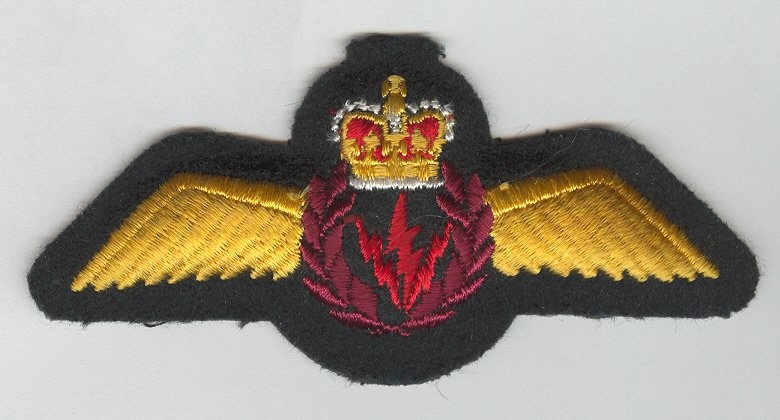 |
Five Electronic Sensor Operators (MCpl to MWO but most were Sgts and WOs). The ESO manned the Radio, Radar, ESM and two in the ASW section (the aft compartment where all the ASW stores were kept as well as the two lookout positions and operated the hand-held cameras). |
| Nose Position: Basically anyone could man it but often an ESO. It was a great seat when flying in the North. You could barely hear the engines and your view including your peripheral vision was all glass. What a view! | |
| All inages and descriptions in this table provided by Rick Bialachowski | |
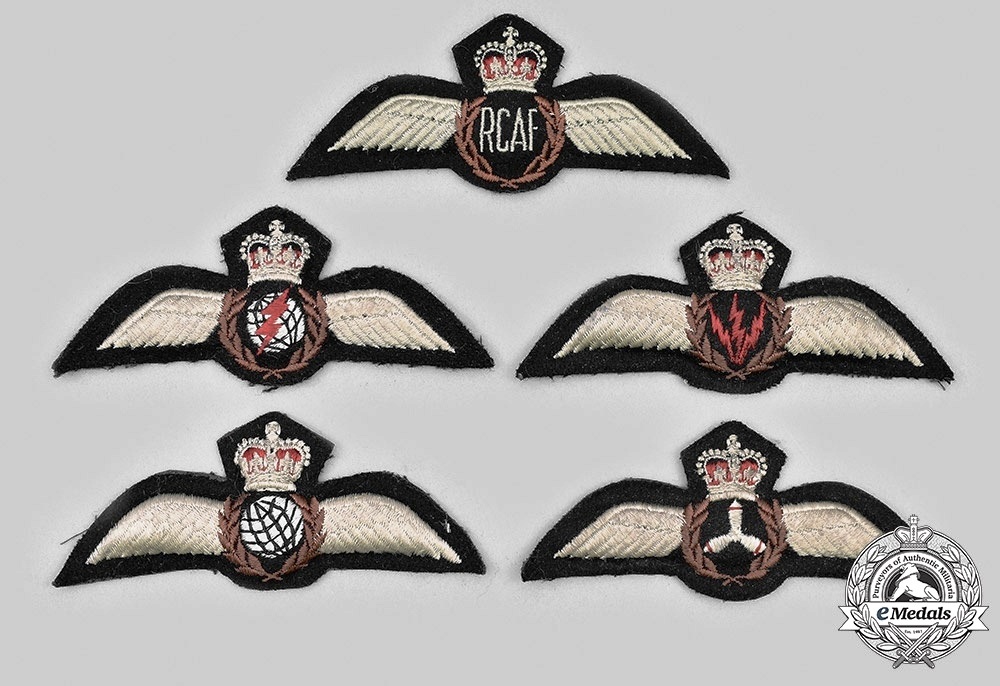 |
| These were the wings issued to Argus crew pre unification in 1968. |
SQUADRONSThe following squadrons flew the Argus.
404 Sqn in Greenwood N.S.
405 Sqn in Greenwood N.S.
407 Sqn in Comox B.C.
415 Sqn in Summerside PEI
449 Sqn in Greenwood N.S.449 , which was the original Argus training squadron, was stood down in 1975. It was the one providing the MOAT course. 404 Squadron then became the training unit. Remnants of 449 were still found in Greenwood in 1978. The aircraft belonged to the base, not the Squadrons. There was a central maintenance facility run by the Base Aircraft Maintenance Officer (BAMEO) who "owned" the aircraft . When a Squadron as tasked with a flight, they were issued the next aircraft in the rotation.
| NOSE OBSERVER |
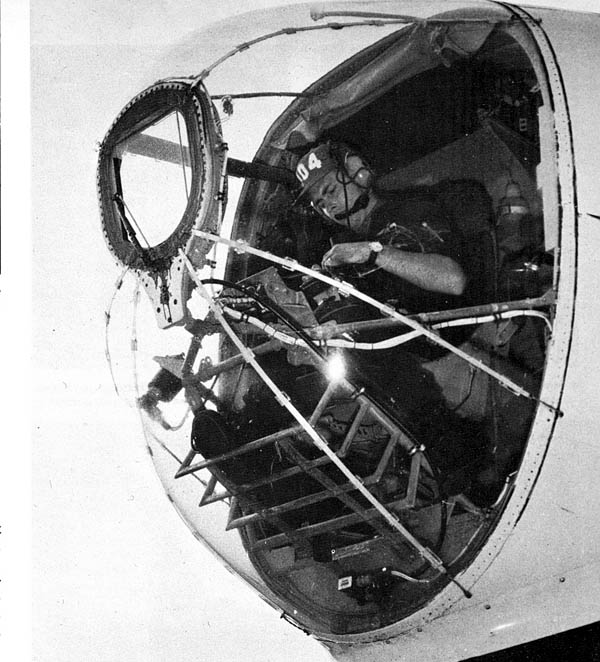 |
| From his "up front" position, Captain Fred Forbes could operate cameras and control the release of ASW markers and sonobuoys. (Canadian Forces photo from Sentinel Magazine Nov-Dec 1969) |
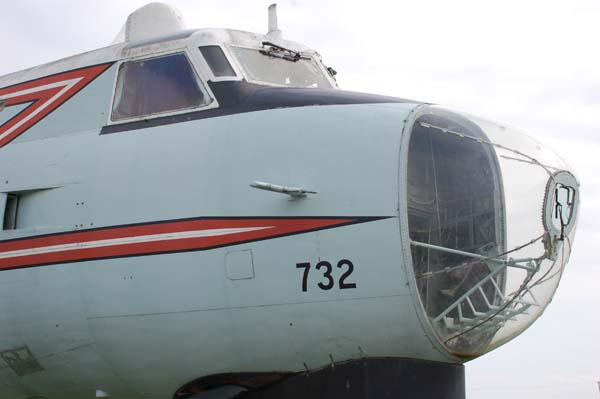 |
| When the observer's seat was in the "Nose" position, the observer is out in the open. (Photo by Jerry Proc) |
|
|
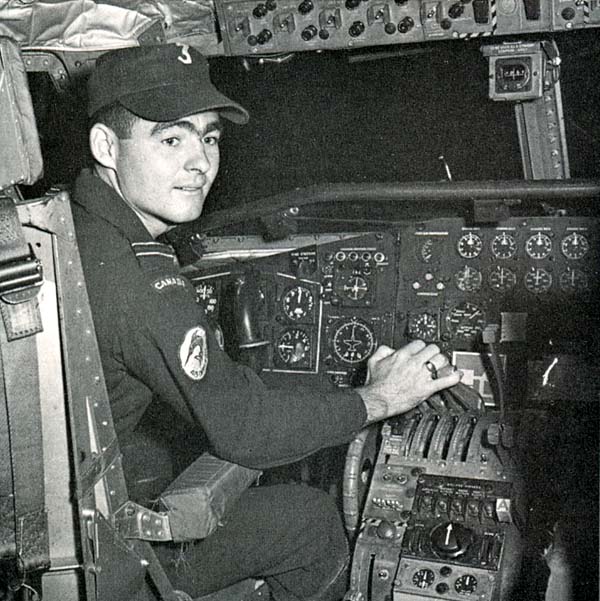 |
| Pilots like Captain P.E. Rowlands rotate during long flights working fours hours on then two off for eating resting or sleeping. (From Sentinel Magazine, May 1968) |
| FLIGHT ENGINEER'S POSITION |
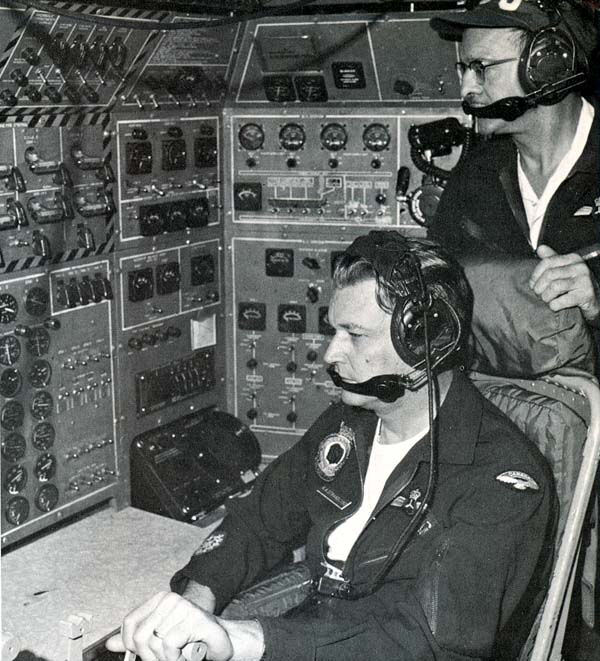 |
| MWO H.A. Strandlund handles the throttles while MWO C.W. Ackland monitors the dials. (From Sentinel Magazine, May 1968) |
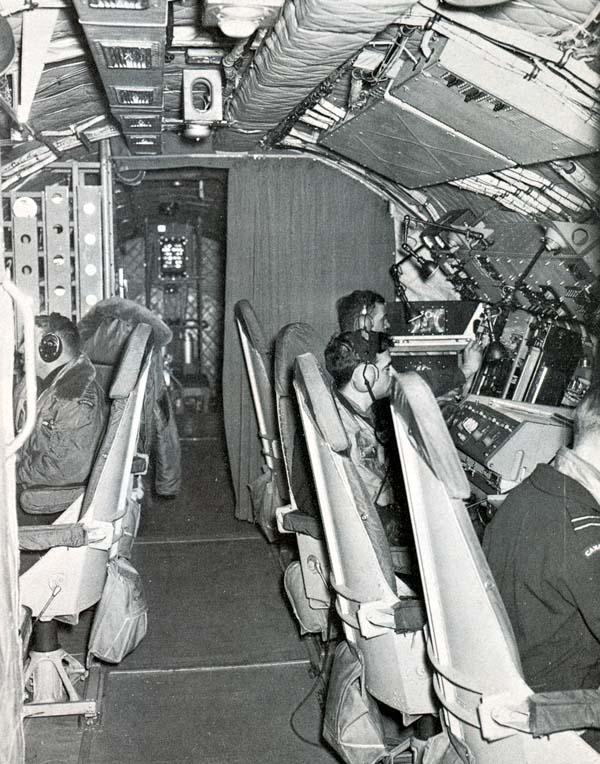 |
| As the Argus becomes airborne, the crew settles into the routine of their varied duties. The photographer is standing in the aisle adjacent to the radar rack and looking aft. On the right (port) side is the TACNAV, the empty logger's/quarterback seat, Jezebel, empty forward Julie seat and someone in the after Julie seat. (From Sentinel Magazine, May 1968) |
| ROUTINE NAVIGATOR |
 |
| 1968: The routine navigator is on the same schedule as the pilots
while the on-duty time for other crew members varies with the intensity
of their work. Here the navigator is using the Loran 'A' capability of
the AN/APN-70 receiver. He is freezing the Lat/Long counters while he inserts
an update.
(Photo from Sentinel Magazine, May 1968)
The instrument cluster : 1) TACAN, 2) Radio Altimeter, 3) Barometric Altimeter, 4) Air Speed Indicator, 5) Clock, 6) Outside Air Temperature Gauge, 7) Lat/Long Counters and L/L update buttons, 8) Master Director Corrector (main ANTAC compass) and 9) ADF/OTPI Indicator. There used to be an old joke in the navigation business. "By definition, a navigator is always lost. By the time he figures out where he is, he has already been there". |
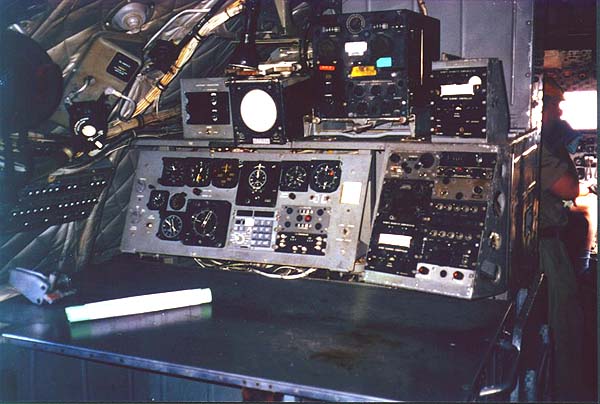 |
| 1980: In this photo, an Omega receiver has been added to the centre-low position of the console. Much of the other instrumentation appears to have changed. (Photo by Randy Schroeder) |
| RADIO |
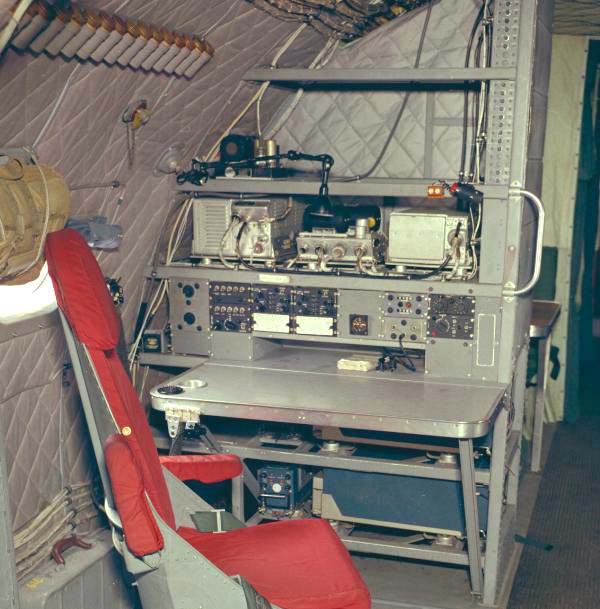 |
| Early Argus radio position, circa 1967. The major piece of equipment
in view is the ARC-502 radio above the control panel. (Photo#
PCN 667 © Department of National Defence. Reproduced with the permission
of the Minister of Public Works and Government Services Canada (2009).
Source: Library and Archives Canada/Department of National Defence)
The Military Occupation Specialty of Radio Officer was discontinued in the 1960’s and those with Radio Officer wings who were sticking around were given a few options. One of these was to cross train over to Air Navigator. When one former crew took the MOAT course in 1978 the course just after his was populated by students who had been Radio Officers and just completed their cross training as Air Navigators. It is believed that this was the last cross training course. |
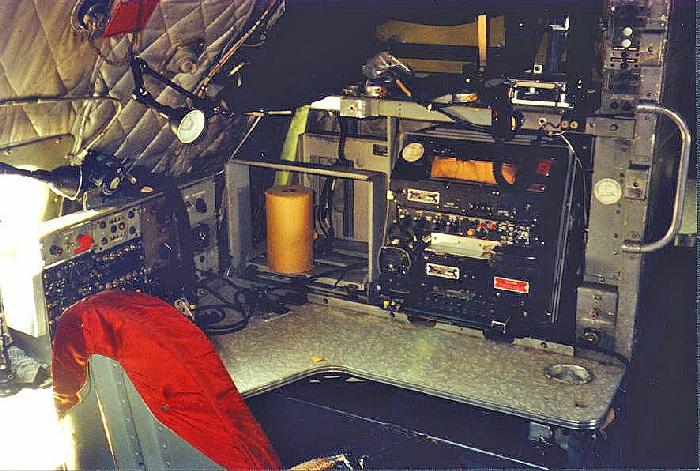 |
| 1980: This the radio operator's station in the Argus
aircraft held in the National Aeronautical Collection in Ottawa. There
are several pieces missing in this photo such as the BID 580 and
KW-7 crypto machines and other odds and ends. (Photo by Randy Schroeder)
The KW-7 was fitted into the rack currently marked by a roll of teletype paper with the BID-580 directly above it. There was a security curtain which could be pulled around the operating position when keying the crypto boxes. No one except an authorized radio operator was allowed to observe the keying process. With this high grade crypto aboard, it meant the radio operator had to put seals on it when away from home base. The seals had to be checked every 12 hours to verify they were intact. The LF teleprinter was just forward (and out of view) of the communications panel at the left side of the seat. The ARC-505 and the ARC-37 were stacked, facing the centre isle, in front of the RO's knees. The ring cap with chain in the cabin wall above the comm console is where the Very Piston was fitted (when used). Fittings may vary slightly over time. |
| GALLEY- REST AREA |
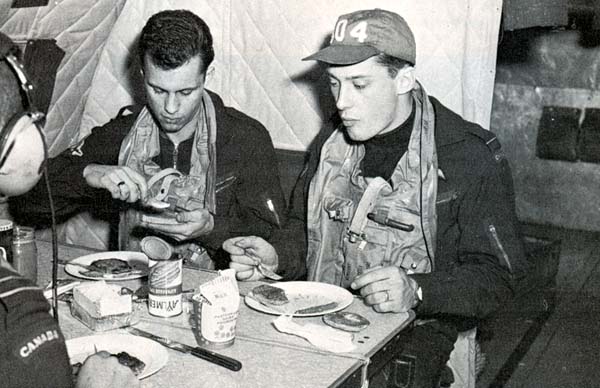 |
| During a tactical situation, the crew eats box lunches but at other times, they prepare simple meals for themselves in the small galley. (From Sentinel Magazine, May 1968) |
To operate an Argus and its complex equipment, a crew of 16 was carried. The pilots and navigators worked on a rotational duty system consisting of four hours on followed by two hours off. The remainder of the crew were required at different times and for different jobs with the intensity of the work either increasing or decreasing depending on whether the aircraft was in transit or engaged in a tactical exercise. In the latter case, all stations were manned and intense concentration was demanded for hours on end as the aircrew demonstrated the ability of the Argus as an anti-submarine system.During those periods when the crew members were off-watch they rested, slept or ate in the galley area where four bunks and four airline-type seats were available. There was also a galley containing a small stove and refrigerator but eating arrangements were sometimes downgraded because of operational requirements. During a tactical situation, for instance, box lunches were handed out and they had to be eaten at the individual crew stations. But, whenever conditions permitted, Argus aircrews would prepare simple meals, such as bacon and eggs, and eat them in relative comfort.. An electric skillet was used to cook and reheat food.
There were no heated storage areas to keep food warm. During a mission , there were different odours which could mix and permeate the tactical compartment of the Argus. One could smell the food being fried in the skillet, cigar or cigarette smoke. a feint odour from the washroom (separated by curtain only) and an odour from the interior of the aircraft itself. Argus crews ate a lot of sandwiches. Fresh bread, peanut butter, jam, cookies and sometimes egg salad was provided. Refreshments such as coffee and juices were also aboard. Four cookies in a cellophane wrapper were also a popular snack.
It was a rough ride when the Argus descended down to 300 feet altitude. Yes... crew got airsick and it was made rougher when the bomb bay doors opened.
| TACTICAL NAVIGATOR |
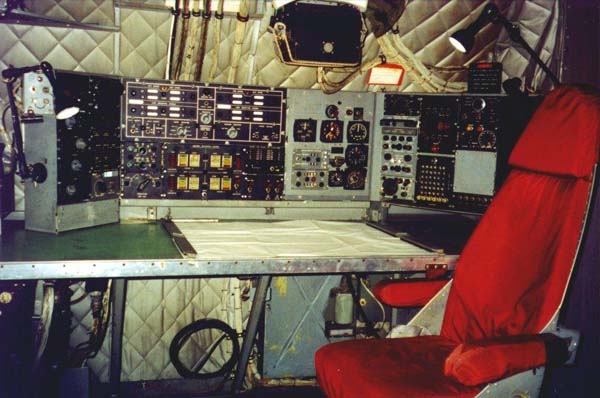 |
| Overhead is the lamphouse that projected a symbol representing the aircraft on the plot table. The symbol would rotate with aircraft track and advance at aircraft ground speed. (Photo by Randy Schroeder) |
|
|
 |
| This is the ASV-21 radar which was carried by the Argus MK II. Its controls were far more simplified than those of the APS-20. Usually the radar was in standby mode so its emissions would not be detected by the target's sensors. When needed, it was turned on for a sweep or two to confirm target bearing and distance, then switched back to standby mode. (Photo by Randy Schroeder) |
Ian Snow expands on the use of the Argus radar. "The technique was to scan on a random time basis (per tables in publication ATP-1) such that the sub couldn't predict when the radar would be turned on for a sweep. Operators would switch on the set only long enough to be comfortable that there were no contacts. The time needed was dependent on factors such as aircraft height and sea state. (Doctrinally speaking, the aircraft would be in and out of the cloud base). Looking up-wind for example, would produce a lot of "sea return" compared to looking downwind. If the sea-state was high enough, the returned energy was sufficient enough to blank out a small target such as a periscope or "snort" (snorkel). Also, out of a typical 40/45 minute snort, the first 20 to 25 minutes only replaced the energy consumed getting the diesels started. Force the boat down once or twice and you can significantly impede its speed of advance and maybe even negate it's mission because it couldn't get into position to attack it's target.Keep in mind that a diesel boat has to snort fairly frequently, especially when it's in transit mode. This was the huge advantage of the Argus, the ability to stay on-station long enough that eventually the boat would have to take the risk and conduct a snort. Then you had him. The trick for the radar operator was to conduct a homing process without changing the radar operating parameters (ie changing ranges, scan speed, pulse width or pulse repetition frequency, etc). The TACNAV would be provided with a fix, then the radar turned off, the power level reduced and then a minute or so later another all-round sweep would be done. To the boat, the weakening RF energy made it look as if the aircraft was flying in the opposite direction. The aim was to get the nose observer and pilot into visual contact before the sub realized the the aircraft was closing in."
| JEZEBEL |
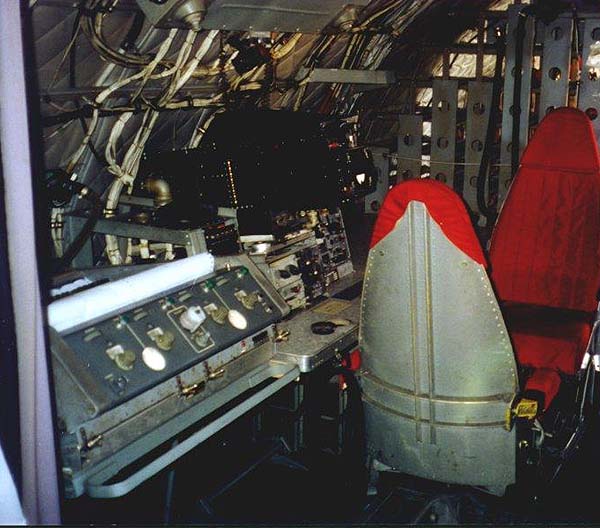 |
| Featuring the AN/AQA-10 sonobuoy recorder. (Photo by Randy Schroeder)
The roll of thermal paper is stored behind the front panel and the paper is drawn flat across the bed to a drive roller at the back. There were four electric stylus (i.e. 4 sonobuoy recordings) that repeatedly swept the paper as it was drawn backwards. Sometimes, there were lots of situations where the Jez operator, interpreting the gram and predicting sub movement and recommending the placement of subsequent buoy drops, arguably took over a component of the TACNAV's job. When you had two individuals who jointly combined talent, wisdom and cooperation you could have a powerful crew. Despite the technology gap with our USN counterparts, Canadian crews frequently produced superior tactical results. |
|
|
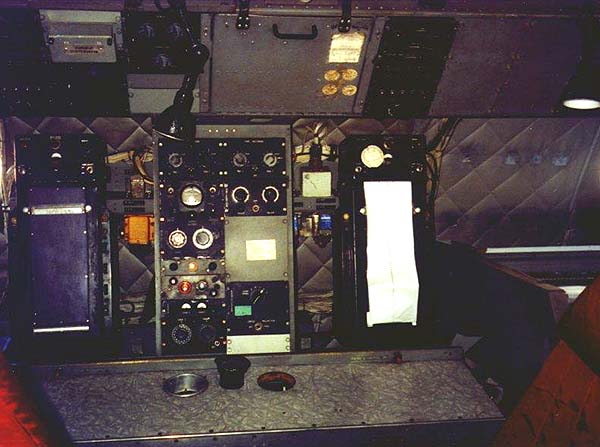 |
| It is believed that these are two AN/AJH-501 chart recorders that were
used to display the Julie echoes or the MAD trace. (Photo
by Randy Schroeder)
There were changes to this position since the late 1960's. There is only one ARR sono receiver control box (centre bottom, left) with two receiver channel controls and eyebrow meters indicating RF signal strength. Above that is a release button for the Retro, with a green light to indicate the gun had reloaded. Above the yellow light are two knobs with meter above. That is the control for the MAD system. Overhead, at one time, were controls for two 1/4 inch reel to reel tape recorders. Around 1967 the PI-214 tape recorder was added (1 inch multi-channel (16?) recorder installed at the ESM station). Also located overhead was the control for the MAD compensation system. It was replaced with an automated piece of kit around 1969. |
|
|
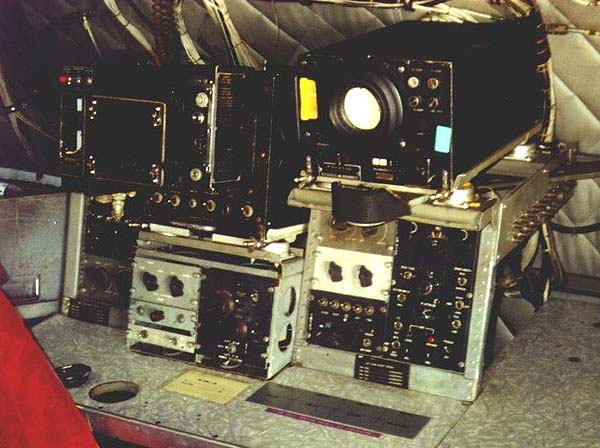 |
| The Pan Adapter Display in the centre, had a camera installed
on the front of it. (Photo by Randy Schroeder)
Each ESM system had four tuning units located in a space under the floor (along with all the antenna switching relays and the rotating DF antenna) in a compartment that also contained a vertical camera, air compressor and other bits and pieces. The operator could control the speed of rotation and even stop the antenna on a target bearing for improved signal reception. He could also tune the chosen receiver to a specific frequency. This gear provided a decent analysis of a relatively steady signal and it was possible to get a very detailed presentation of the pulse shape and to fingerprint some radars. |
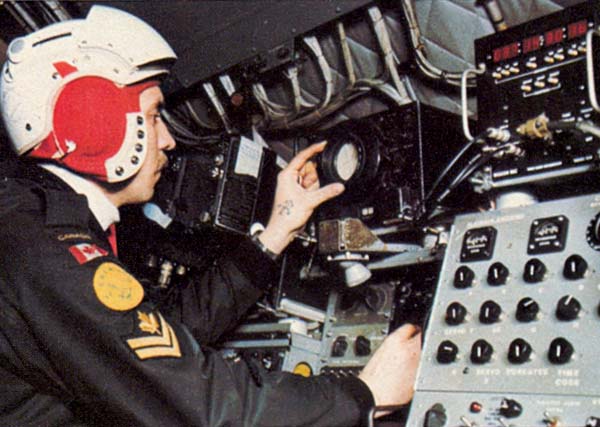 |
| MCpl Chipman is looking at the ESM scope. The equipment to his right was introduced sometime later. At the top right that is believed to be a time code generator and to the lower right, the audio level controls for the PI-214 magnetic tape recorder. This was added to make the ESM analysis more accurate. (Canadian Forces photo HC 81-65. Sentinel Magazine 1981/03) |
| ASW |
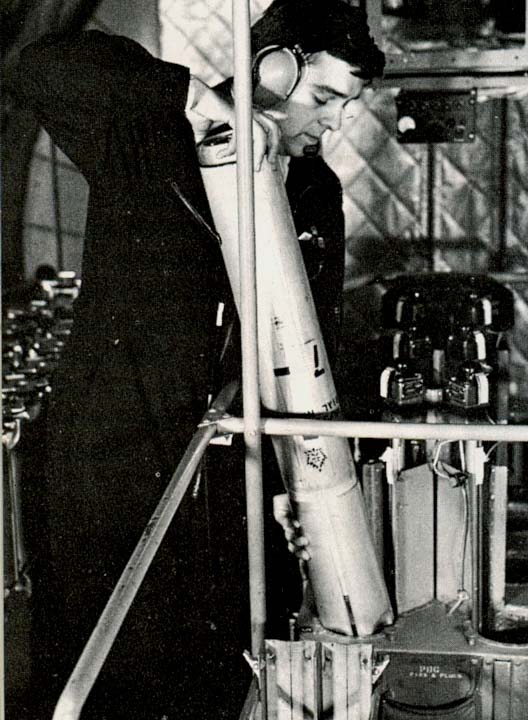 |
| Sonobuoys being loaded into the launchers. (From Sentinel Magazine, May 1968) |
 |
| The weapons bay could carry a variety of weapons. Here a torpedo is
being carefully loaded into the bay. (From Sentinel Magazine, May 1968)
In addition, a weapons carrier was available for the Argus. It would release a bomblet that was shaped to have the same flight profile as a MK 54 depth charge. In the center of the bomblet, there was a hollow tube into which was inserted a blank shotgun shell which would fire off on impact with the water and releasing a puff of smoke. A normal stick of MK-54's [1] was eight and the canister was programmed to release a bomblet representing the first and last depth charges. The run was photographed with the vertical camera so the Intelligence folks could measure the attack error taking into account target course and speed, offset of the smoke markers from the target etc.... |
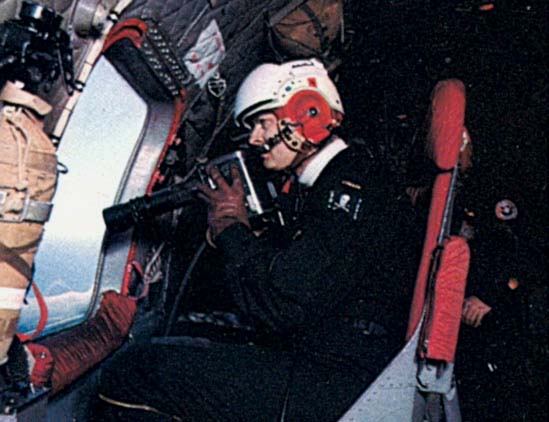 |
| Sgt. Ken Kitt, an airborne electronic Sensor Operator,
photographs a target of interest with the 11 inch HULCHER camera
which used 70 mm film pre-loaded by Base Photo. On both the 7" and
11 " cameras, the film roll was advanced by a 28 VDC motor which
received power from a capped 2-pin Cannon plug receptacle at each lookout
position.
This observation post was in the ASW area on the starboard side. All the ROs/Observers were trained in it's use and the person on-duty would man the camera whenever required. For intelligence photography, the aircraft would fly a box pattern with 270 degree turns at the corners in order to photograph the target. (Canadian Forces photo. Sentinel Magazine 1981/03) |
 |
| Sgt. Ray Allen at the the ASW starboard position. (Canadian Forces photo HC 81-63 from Sentinel Magazine 1981/3) |
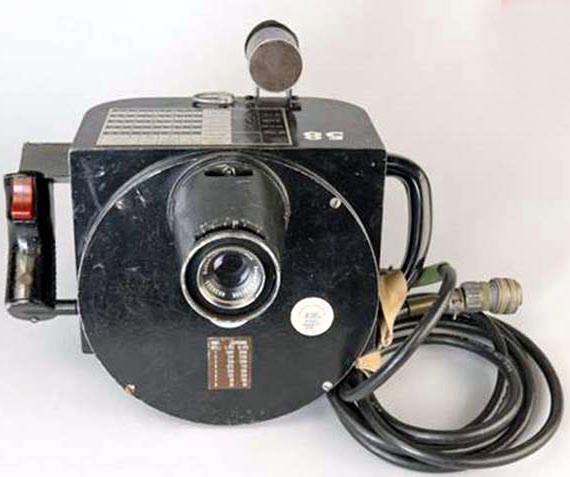 |
| This is the Hulcher 70mm camera used by the Sensor Operator. It had two lens options - 3 or 11 inch focal length. Darrel Newman worked at MPEU where he trialed a replacement lens of 6 inch focal length. It gave much better results than either the 3 or 11 inch lens but was never adopted. (Photo credit umknown) |
Each ASW station had a 20 foot or so long intercom cord so the operators could move about. The port side position had a lookup window. Aft of the positions is the Librascope launcher. To the right are two 10 inch (approximately) diameter tubes for manually throwing out ASW stores, tubes filed with newspapers and mail to the exercise submarines, etc. The two lids opened independently. In the centre over the Librascope, is the 6-chute sonobuoy launcher. Each tube had a pneumatically operated trigger finger that would eject the sono out of the aircraft when commanded by the Tactical Navigator.Behind the sono tubes was the Retro Launcher, which fired a smoke/flame marker backwards at a/c forward speed. It was controlled by the Tactical Navigator, but with release buttons at all the lookout positions.
On the port side is a similar but shorter bin for sono storage. Behind that are bins for storing SUS and smoke markers. Above these bins is a rack for storing magnesium flares. These flares are still used today in the Search and Rescue business. They are dropped from altitude via parachute (release lanyard was attached to a spring clip beside the manual launch tubes) to illuminate the area for a subsequent low observation pass.
At the very back was a bulkhead with a canvas covered access hole. There was a flux gate for the compass system back there plus of course the MAD detector in the boom and a MAD compensation unit.
INTERCOM CHECK
When the Pilot (the VPCC) called for a comms check to ensure if everyone was on the intercom, the roll call started at the front of the aircraft and each position would identify itself. One would hear such responses as “Co-pilot, FE, Radio, Routine Nav, Radar, TACCO, Tacnav, JEZ1, JEZ 2, ESM and ASW”. Each crew member would wait for his turn and if the position immediately before him did not respond in about 4 or 5 seconds the row call would continue. When completed they would find out why someone missed responding. On the Aurora CP140, JEZ 1 and JEZ 2 became ASO 1 and ASO 2 respectively.
The Argus was nosier on the outside in comparison to the inside. When the aircraft was at cruise altitude, the crew could talk normally in the tactical compartment. Normally the crew wore headsets/flying helmets since they were connected to the aircraft’s intercom system. For extra hearing protection, some crew would often use foam earplugs in addition to the headset/helmet. The engines were loud on ground run ups and on takeoff but not so loud when cruising.
CREW COMFORT
 |
| Pictured here is the port side air scoop. (Photo by Jerry Proc) |
To keep the crew warm and conformable, there were two internal cabin heaters . The bomb bay also had its own separate heater. Air was drawn into the heaters through scoops located behind and below the pilot's and copilot's positions on the port and starboard sides of the aircraft. The bomb bay had its own separate air scoop near the tail.
ADDITIONAL NOTES
RADIO OPERATORS and NAVIGATION
In days gone by, Radio Operators, AI's (Air Interceptor officers on the CF-100 and 101), and LR's (Long-range Navs) all took the same basic Navigators course at the Air Navigation School, Winnipeg. In phase II ,each trade specialized in its own role. Around 1963 or 64, the decision was made to phase out RO's so training shut down. Ian Brown indicates that "I was going through Officer Candidate School Centralia as a navigator candidate when in circa October 1965 it was realized that some sort of calculation error had been made and Maritime Air was going to run out of RO's. On turning up for Monday morning classes we non-pilot candidates were given a choice: with the change of contract terms we could carry on as RO candidates or opt out.
The first four courses through Winnipeg graduated RO's from books salvaged from the closing of the Clinton
school and lesson plans cobbled together from wherever. At the same time, the school was designing a modernized course more tailored to developing Maritime Command needs. From that point on, the graduates were ESO's - Electronic Systems Officers. As mentioned elsewhere, the non-commissioned AESOP program replaced the RO/ESO's circa 1969.The Air Nav program carried on in Winnipeg remained basically unchanged until the 1990s. The school was always under the control of Air Transport Group. That changed about 1994 with the appointment of Sandy Kerr as the CO. It took a couple more years but an Air Command review was held and the course completely revamped, from a WW II long-range bomber Nav perspective to a modern Maritime TACCO perspective.
Andy Sawatsky (injured but survived the Summerside Argus crash and also a fellow Sea King TACCO) who was the ANS Standards Officer at the time. He told me a story about when, purely by chance, the students of the last "LR" course and the first "Maritime" course met in the mess to hear a guest speaker. It became painfully obvious that the two groups had no idea what the other was talking about. The LR students were in their 'box' thinking in terms of supporting the pilot by keeping him and his aircraft on track. The "maritime" students were thinking like mission commanders: executing a mission change, taking control of the second Dash-8 training aircraft, directing a search pattern for a SAR target or some other type of mission, etc. In other words, the student was being taught from the get-go to think like a commander, not as simply a supporting member in a crew waiting for somebody to give him/her direction."
SAR KIT (MA-1 system)
A Search and Rescue raft system could be launched from the back of the aircraft using a slide. It was composed of four bags - a 10 man raft, survival kit, survival kit and a 10 man raft. These were all joined by lengths of rope. The drill was to fly across the wind, just upwind of survivors in the water. The back end crew launched the system on the call of the nose operator. If the timing was right you ended up with 450 feet of raft, rope and survival gear which would land slightly upwind of the survivors. The rafts inflated on contact with the water and having less drag than the survival kits, the system would end up draped in a "U" shape around the survivors.
Select this link to read the story about the wife of an Argus crewmember who went out on a 12 hour patrol.
FOOTNOTES:
[1] The Mk 54 depth charge carried 250 lbs of Torpex and had an overall weight of 354 lbs. A hydrostatic fuse was located on the tail.
[2] Pronounced "hull-share". There were three Haltcher cameras onboard the Argus. A 7 inch (178mm) camera was used used at the Nose Observer's position while a 7 and 11 inch (279mm) units were used at the ASW station. The 11 inch camera was not used in the nose because there was insufficient room to manipulate it. The 7 inch camera was used instead, however, there was too much distortion in the nose perspex, so photos were generally taken out the side of the perspex .
QUESTION:
1) Can anyone confirm the use of the Konica KD-2 (35mm) camera or have a photo of it?
Contact: Jerry.Proc@sympatico.ca
Credits and References:1) Ian Snow RCAF/CF retired.<va3qt-4(at)sympatico.ca>
2) Argus radio photo courtesy http://www.geocities.com/cp107argus3/SchroederPhotos/742.htm
3) Bert Campbell <navigator1(at)eastlink.ca> 5,000 Argus Hours - Radio Officer/Navigator
4) Extracts from "Argus Patrol" story, Sentinel May 1968.
5) Extracts from the Argus Farewell story. Sentinel Magazine 1981/03 page 11
6) Deke Chapin <deke.buckie(at)rogers.com>
7) Darrel Newman <darreljn(at)rogers.com>
8) Rick Bialachowski < bialachowski(at)sympatico.ca>